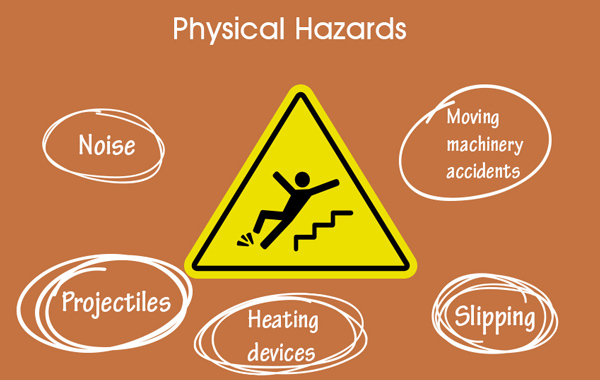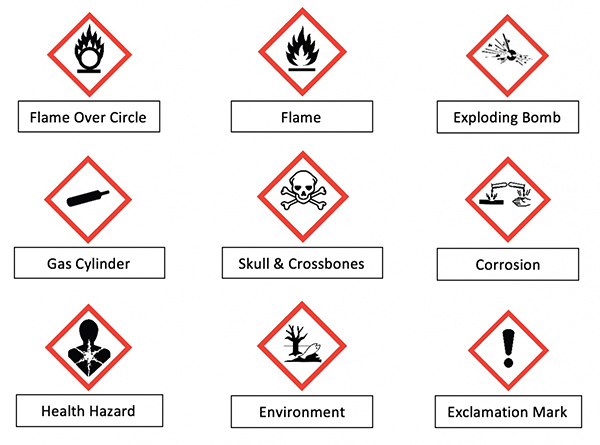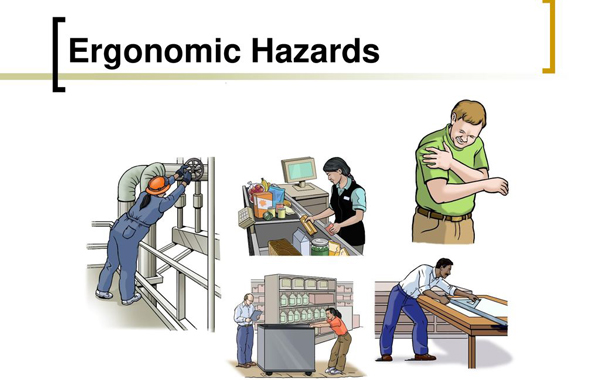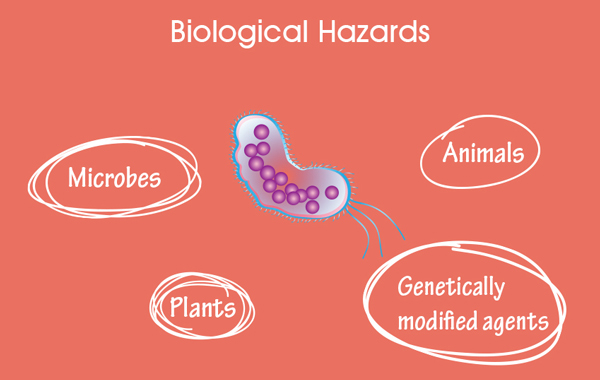Hazards are inconvenient and costly. The average company gets more than two fines on average per inspection.
With the WorkSafe fines reaching $3,000,000 for reckless business practices that expose employees to harm. With planning and some forethought, you can avoid hazard-related losses.
Workplace hazards affect employees. Over 600 New Zealanders die each year from world related injures and disease. A loss of income to thousands of households and physiological impact on a community.
For the workplace, it’s a loss of skilled staff plus health and medical costs, not to mention extremely upsetting for the staff and management.
To avoid losses, stay aware of potential workplace hazards. Look around your workplace to identify which hazards apply to you. Then take the required measures to keep your staff and business safe.
1. Physical Workplace Hazards
The workplace environment presents different levels of threats to workers. Physical hazards are obstacles, objects or elements that present potential threats. Solve these with proper workplace design and adherence to safety processes.

a) Housekeeping Mistakes
Slips and falls happen because of liquids or elements, such as boxes or cables, lying around. Clutter blocks drainage or prevents effective movement around the workplace. It includes things like disorganized wiring and misused storage facilities.
To prevent accidents, start a culture where your staff clean as they go. Waiting on cleaning staff to store tools creates a lack of personal responsibility. It leads to avoidable exposure to hazards.
When cleaning up needs specialized skills, alert the relevant manager or department. This way, you solve problems soon before they occur.
Consider using safety signage in high-risk areas. These include floors where spills are common or stacked loads that can topple over. Safety posters identify hazards and keep staff from becoming complacent. Have a first aid poster with emergency numbers handy in case any incidents occur.
b) Sharp Objects and Machinery
In the retail sector, cuts from sharp objects like knives and box cutters are common. It’s a result of lack of training or taking shortcuts. It is important to establish safety procedures that instruct employees on how to safely carry out their duties.
Workplaces with machinery or mechanical moving parts create a potential hazard. The common injuries include broken bones, strained muscles or even death. Operate machines with care and full attention.
To prevent casualties, ensure staff have protective wear. They include hard hats for machine workers and gloves for handling sharp objects. With training, scheduled breaks and safety processes, incidents should decline.
First aid is crucial in keeping an injury under control. Distribute adequate first aid kits to ensure first aid is accessible immediately after an incident occurs. Keep them stocked with essentials and emergency numbers for paramedics.
c) Extreme Temperature and Fire
Different seasons come with a shift in temperature. Design your workplace to regulate these variations. Exposure to extreme temperature leads to heat stress, hypothermia, sunburn or heat stroke. Protect your employees with good ventilation and air conditioning.
Fire is an ever-present hazard in many workplaces. Especially if you work with machines that can overheat or chemicals that combust. Another risk factor is publicly accessible buildings. They are vulnerable to arson.
To keep staff safe, the first line of defence is installing a fire alarm and sprinkler system. Practice safety drills until reactions to a real emergency are immediate and orderly.
Place fire extinguishers, fire blankets and first aid kits around the workplace. Most first aid kits contain masks that can help people breathe in smoky rooms. Fire blankets will protect your face from flames as you evacuate from a burning building. The first aid kit helps to treat burns and scratches before medical care arrives.
2. Chemical Workplace Hazards
An unfortunate habit by companies that deal with chemicals is stockpiling them. Since chemicals tend to be expensive, they stay for far too long in anticipation of future use. This exposes your staff to danger since some chemicals become hazardous with time. For example, ether becomes unstable over time and turns into poisonous peroxide. Establish a control system that ensures all chemicals that come in first go out first.
 Source: Scholarblogs
Source: Scholarblogs
a) Chemical Handling
Create an inventory of your products. Note expiry dates to ensure you use the chemical before it expires. Avoid transferring chemicals from one container to another. This creates allows for harmful reactions to occur.
Ensure all staff are trained on how to handle chemicals. They need protective gear that allows them to work and move comfortably. Practice proper labelling to ensure your team is aware of what harmful chemicals they are handling.
For swift action, place eyewash stations and first aid kits around your workplace. Acting fast prevents a minor injury from escalating. Eyewash stations are essential in removing contamination before it infects or damages the eyes.
b) Asbestos Poisoning
This is a particularly harmful substance that deserves specific mention. It causes breathing complications and mesothelioma after exposure. There’s no known way of removing the fibres once they get to the lungs and the disease they cause has no cure. It’s found in building projects built before 2000.
Workers maintaining buildings built with asbestos are at risk. The only way to prevent damage is to limit or completely prevent exposure to the fibres. If you have asbestos in your building, get specialized asbestos contractors to advise you on its removal.
3. Social Workplace Hazards
Workplaces are dynamic. You could have the best safety processes but still, experience many workplace accidents. Protect the mental health of your staff by keeping workplace stressors in mind.
25% of employees admit to their jobs being the top source of stress in their lives. Stress is sometimes psychological and caused by harassment or heavy workload. Work can stress people if they feel underprepared or overburdened. This can spiral into low self-esteem and self-harm.
Create an open-door policy where your staff can come to you with any problems they face. This way, you create a culture of openness that helps you know when the team is overwhelmed or need new training. Stress is a harmful response that happens when job requirements don’t match resources. Staying aware of this helps reduce the stress levels for your staff.
b) Workplace Violence
This refers to disruptive behaviour or threats of physical abuse at the workplace. It can come from fellow colleagues or clients and suppliers. Whether verbal or physical, abuse has adverse effects on the performance of your staff.
Due to an increasingly diverse workforce, violence is a rising concern for employers. Do your part with sensitisation campaigns that encourage tolerance and professionalism at work. Reinforce good behaviour and have penalties for people who threaten violence. You cannot afford to be on the fence while your staff suffer fear or intimidation.
c) Poor Hazard Communication
Communication breakdown at the workplace leads to avoidable accidents. Make sure your staff are aware of all the safety precautions. When handling dangerous substances, communicate the potential risks. Emphasise why it’s important to follow procedures. This increases compliance and promotes a sense of workplace cohesion.
d) Workplace Bullying
Bullying is persistent actions towards a co-worker aimed at degrading them. It creates a huge risk to the mental health of your employees. It leaves an employee feeling helpless and defenceless. It undermines the right to dignity at work.
4. Ergonomic Workplace Hazards
Non-impact injuries from overexertion are the leading cause of joint inflammation and pain. Excessive physical effort can lead to discomfort or blinding pain in others. Prevention is the best cure against overexertion. Other causes of ergonomic hazards are poor lighting and poor posture.
 Source: ehsdb.com
Source: ehsdb.com
a) Repetitive Tasks
Use ergonomic principles to reduce the risk of fatigue, short term pain or illness. Awkward movements can affect posture, the back and other strained areas of your body. Instead of repeating a task, practice task variety to reduce repetitive movements.
Space out your tasks to give the body time to recover. Teach your staff to value breaks and lead by example. The health of your staff leads to long-term productivity and success.
b) Lifting and Handling Materials
Improper technique while lifting, lowering or twisting will cause strains and serious injuries. Training empowers your workers with skills they need to maintain ergonomic practices. Supplement this training with safety signage as a reminder of workplace safety measures.
Position safety tools within reach this includes a first aid kit. If someone sprains a leg, wrapping the affected joint with a bandage can help your staff recover in good time.
5. Biological Workplace Hazards
When working with animals, people or plants, you can encounter biological hazards. They include viruses, bacteria, injuries sustained from animal care and exposure to toxic plants or blood. These biological agents can cause injuries, disease or illness in humans.
 Source: InterFocus
Source: InterFocus
Emphasise the importance of personal hygiene in prevention. Most illness-causing agents are transmitted directly through physical contact or indirectly through ingestion. Practice good hand hygiene and wear protective gear where necessary.
Clean and disinfect all the time and keep up your immunisations. This prevents diseases like rabies. Keep your immunity high and have a first aid box that can help ease symptoms of diseases. Painkillers and anti-inflammatory medications keep staff comfortable before medical help arrives.
Focus on Prevention and Preparation with Alsco NZ
Prevention is the best way to handle workplace hazards. After identifying which ones apply to your business, take immediate action. Foolproof prevention measures include:
- Training – Train employees on safety protocols as soon as they join your organisation. Conduct periodic refreshers for everyone to re-emphasise the importance of safety.
- Protection Resources – Wear protective gear to protect yourself from injury or illness. Provide ample first aid kits to help out in case an incident occurs. Fast action can sometimes be the difference between life and death.
- Culture – An open culture ensures open communication. Your employees will be able to communicate their needs and frustrations to you. This will increase job satisfaction and decrease workplace stress.
Alsco Nz provides your workplace with top of the line safety equipment to keep your workplace running smoothly.
Speak to a customer care agent today and equip your workplace with managed first aid kits. For an annual fee, Alsco NZ will keep your workplace first aid kit stocked and replenished every three months; meaning you can focus on your business.



